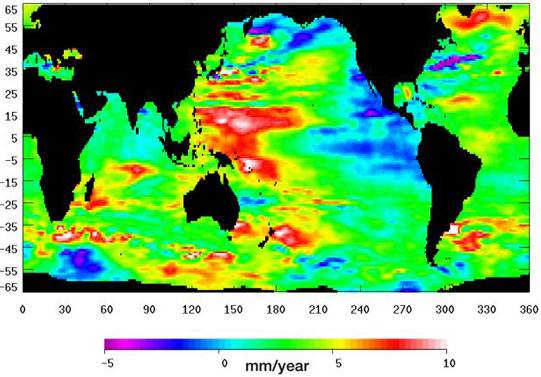Trakar
VIP Member
- Feb 28, 2011
- 1,699
- 73
- 83
the university of Colorado graph is just fine. the bravenewclimate blog is irrelevent as the graph was found during a google image search.
Well that graph says University of Colorado, but it is from the BraveNewClimate blog site. I don't mean to doubt the blog's reliability, but I would really prefer to see a graph directly from and on a legitimate and authentic science site. I ran a cursory search at the Sea Level Research Group site (CU Sea Level Research Group | University of Colorado) and didn't see the graphic, but I haven't really spent any time in a more detailed search, I wanted to check and see if you had a better link first (sorry I wasn't more specific in what I was looking for last post).
satellite altimetry produces maps that show different sea level rise in different places. eg the south pacific seas show ~10mm/yr increase. the map states this is data for the last 20 years. are we to believe that the sea level is 200mm higher there and still rising? what is stopping the water from spreading out? I cant help but think that this is an artifact of volcanic and seismic activity that is distorting the gravity field.if that is the case then perhaps the altimetry results for the west peninsula of antarctica are similarly being affected by the volcanoes there. etc.
Until we can track down the actual graphic representation, and more importantly the data and methodologies from which the graphic is derived, it is difficult to do much beyond speculation. Remember, the crust, and the mantle it floats upon, are only semi-rigid in and of themselves. In most cases, it isn't the volcanoes which cause the mascon gravitational anomalies, it is the piling-up of crustal plates behind and ahead of a deep subduction area. This piling up causes a general geological uplift (think the early stages of a "buckling"). This gives us two mechanisms of local sea level rise beyond any that might be attributable to global average sea level rise (you see similar potentials in areas of negative sea level rise): 1) the local sea is actually being pushed up by a rising sea floor, 2) the mascon of the bulging crust is actually attracting sea water to pile up over top of the rising sea floor. The surface of the oceans subtly mirror the contours of the seafloor below them. The crucial point is whether or not this graphic, and more importantly, the data and the analysis understood and accounted for this variable. It is entirely possible that the satisfaction of our curiosity may lie in the paper and corresponding data from which this graphic was extracted.
((oh, and btw, pardon my ignorance but "CAGW"?))
CAGW is catastrophic anthropogenic global warming.
"Catastrophic" is a relative term and more often used in hyperbole than measured consideration.
Im not doing a scientific paper, or even a high school project. if I see the same type of map or graphic from different sources I assume that the overall basic idea is accepted in the scientific community.
I did not intend to convey any other meaning, what I am talking about, is that until we can see the actual study from which this particular graphic was derived we have no way of knowing if this was a gross data plotting which entails a composite of factors and influences many of which have nothing at all to do with climate change issues.
I dont go to the SIs of scientific papers and run R code to check their methodologies and illustrations. nor do 99.9% of the public. if blogs and such did not reprint graphics from universities and govt institutions then they would often simply disappear. eg. a link to a temp graph from GISS will typically break within a day or two, and GISS has made it impossible for information caching programs like 'the wayback machine' to capture past data sets.
The point isn't what the pretty pictures look like, the point lies in the data and the analysis from which the graphic is derived. As these are composite measurements averaged over such a long period there are many things that could contribute to such regional rises and falls.




